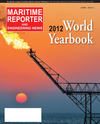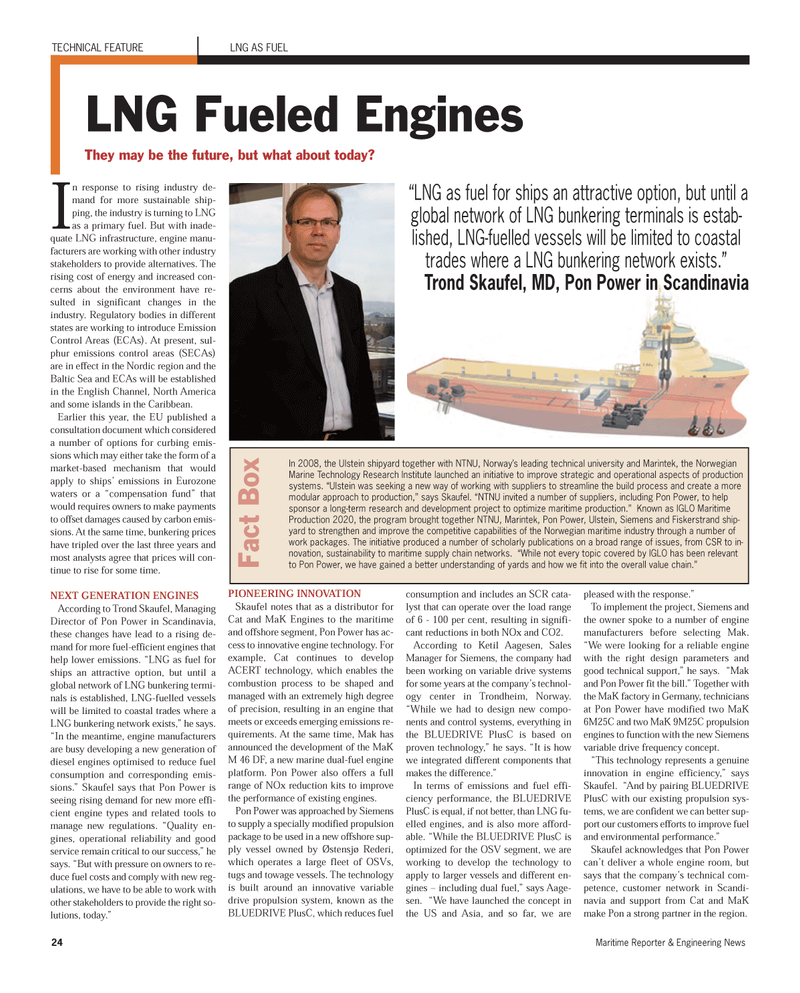
Page 24: of Maritime Reporter Magazine (June 2012)
Annual World Yearbook
Read this page in Pdf, Flash or Html5 edition of June 2012 Maritime Reporter Magazine
24Maritime Reporter & Engineering News In response to rising industry de-mand for more sustainable ship-ping, the industry is turning to LNGas a primary fuel. But with inade-quate LNG infrastructure, engine manu-facturers are working with other industry stakeholders to provide alternatives. The rising cost of energy and increased con- cerns about the environment have re- sulted in significant changes in the industry. Regulatory bodies in different states are working to introduce Emission Control Areas (ECAs). At present, sul- phur emissions control areas (SECAs)are in effect in the Nordic region and the Baltic Sea and ECAs will be establishedin the English Channel, North America and some islands in the Caribbean. Earlier this year, the EU published a consultation document which considereda number of options for curbing emis-sions which may either take the form of a market-based mechanism that would apply to ships? emissions in Eurozone waters or a ?compensation fund? that would requires owners to make payments to offset damages caused by carbon emis- sions. At the same time, bunkering prices have tripled over the last three years and most analysts agree that prices will con-tinue to rise for some time. NEXT GENERATION ENGINES According to Trond Skaufel, Managing Director of Pon Power in Scandinavia, these changes have lead to a rising de- mand for more fuel-efficient engines that help lower emissions. ?LNG as fuel for ships an attractive option, but until a global network of LNG bunkering termi- nals is established, LNG-fuelled vessels will be limited to coastal trades where aLNG bunkering network exists,? he says. ?In the meantime, engine manufacturers are busy developing a new generation of diesel engines optimised to reduce fuelconsumption and corresponding emis-sions.? Skaufel says that Pon Power is seeing rising demand for new more effi- cient engine types and related tools tomanage new regulations. ?Quality en- gines, operational reliability and goodservice remain critical to our success,? he says. ?But with pressure on owners to re- duce fuel costs and comply with new reg- ulations, we have to be able to work with other stakeholders to provide the right so- lutions, today.? PIONEERING INNOVATION Skaufel notes that as a distributor for Cat and MaK Engines to the maritimeand offshore segment, Pon Power has ac- cess to innovative engine technology. For example, Cat continues to develop ACERT technology, which enables the combustion process to be shaped and managed with an extremely high degree of precision, resulting in an engine thatmeets or exceeds emerging emissions re- quirements. At the same time, Mak has announced the development of the MaK M 46 DF, a new marine dual-fuel engine platform. Pon Power also offers a full range of NOx reduction kits to improve the performance of existing engines. Pon Power was approached by Siemens to supply a specially modified propulsion package to be used in a new offshore sup- ply vessel owned by Østensjø Rederi, which operates a large fleet of OSVs, tugs and towage vessels. The technology is built around an innovative variable drive propulsion system, known as the BLUEDRIVE PlusC, which reduces fuelconsumption and includes an SCR cata-lyst that can operate over the load range of 6 - 100 per cent, resulting in signifi- cant reductions in both NOx and CO2. According to Ketil Aagesen, Sales Manager for Siemens, the company had been working on variable drive systems for some years at the company?s technol- ogy center in Trondheim, Norway. ?While we had to design new compo- nents and control systems, everything in the BLUEDRIVE PlusC is based onproven technology,? he says. ?It is how we integrated different components that makes the difference.? In terms of emissions and fuel effi- ciency performance, the BLUEDRIVE PlusC is equal, if not better, than LNG fu- elled engines, and is also more afford- able. ?While the BLUEDRIVE PlusC isoptimized for the OSV segment, we are working to develop the technology to apply to larger vessels and different en- gines ? including dual fuel,? says Aage- sen. ?We have launched the concept in the US and Asia, and so far, we are pleased with the response.? To implement the project, Siemens and the owner spoke to a number of engine manufacturers before selecting Mak. ?We were looking for a reliable engine with the right design parameters andgood technical support,? he says. ?Mak and Pon Power fit the bill.? Together with the MaK factory in Germany, technicians at Pon Power have modified two MaK 6M25C and two MaK 9M25C propulsion engines to function with the new Siemens variable drive frequency concept. ?This technology represents a genuineinnovation in engine efficiency,? says Skaufel. ?And by pairing BLUEDRIVE PlusC with our existing propulsion sys- tems, we are confident we can better sup- port our customers efforts to improve fuel and environmental performance.? Skaufel acknowledges that Pon Power can?t deliver a whole engine room, but says that the company?s technical com- petence, customer network in Scandi- navia and support from Cat and MaK make Pon a strong partner in the region. TECHNICAL FEATURE LNG AS FUELLNG Fueled EnginesThey may be the future, but what about today? ?LNG as fuel for ships an attractive option, but until aglobal network of LNG bunkering terminals is estab-lished, LNG-fuelled vessels will be limited to coastaltrades where a LNG bunkering network exists.? Trond Skaufel, MD, Pon Power in Scandinavia In 2008, the Ulstein shipyard together with NTNU, Norway?s leading technical university and Marintek, the Norwegian Marine Technology Research Institute launched an initiative to improve strategic and operational aspects of production systems. ?Ulstein was seeking a new way of working with suppliers to streamline the build process and create a more modular approach to production,? says Skaufel. ?NTNU invited a number of suppliers, including Pon Power, to help sponsor a long-term research and development project to optimize maritime production.? Known as IGLO Maritime Production 2020, the program brought together NTNU, Marintek, Pon Power, Ulstein, Siemens and Fiskerstrand ship- yard to strengthen and improve the competitive capabilities of the Norwegian maritime industry through a number of work packages. The initiative produced a number of scholarly publications on a broad range of issues, from CSR to in- novation, sustainability to maritime supply chain networks. ?While not every topic covered by IGLO has been relevant to Pon Power, we have gained a better understanding of yards and how we fit into the overall value chain.? Fact BoxMR June12 # 3 (17-24):MR Template 6/11/2012 9:25 AM Page 24

 23
23

 25
25
